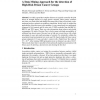Free Online Productivity Tools
i2Speak
i2Symbol
i2OCR
iTex2Img
iWeb2Print
iWeb2Shot
i2Type
iPdf2Split
iPdf2Merge
i2Bopomofo
i2Arabic
i2Style
i2Image
i2PDF
iLatex2Rtf
Sci2ools
ISAMI
2010
2010
A Data Mining Approach for the Detection of High-Risk Breast Cancer Groups
It is widely agreed that complex diseases are typically caused by the joint effects of multiple instead of a single genetic variation. These genetic variations may show very little effect individually but strong effect if they occur jointly, a phenomenon known as epistasis or multilocus interaction. In this work, we explore the applicability of decision trees to this problem. A case-control study was performed, composed of 164 controls and 94 cases with 32 SNPs available from the BRCA1, BRCA2 and TP53 genes. There was also information about tobacco and alcohol consumption. We used a Decision Tree to find a group with high-susceptibility of suffering from breast cancer. Our goal was to find one or more leaves with a high percentage of cases and small percentage of controls. To statistically validate the association found, permutation tests were used. We found a high-risk breast cancer group composed of 13 cases and only 1 control, with a Fisher Exact Test value of 9.7
| Added | 13 Feb 2011 |
| Updated | 13 Feb 2011 |
| Type | Journal |
| Year | 2010 |
| Where | ISAMI |
| Authors | Orlando Anunciação, Bruno C. Gomes, Susana Vinga, Jorge Gaspar, Arlindo L. Oliveira, José Rueff |
Comments (0)

